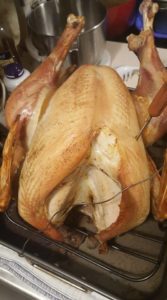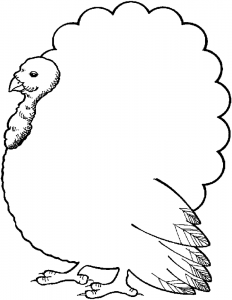2018 was the year of the turkey at the homestead, and it occurred to me that I never shared a “lessons learned” post on the blog. In sharing, I hope to encourage others who’re thinking of taking the plunge. I would also submit that the winter solstice is a perfect time to ponder homestead plans for next year, so here’s our story for what it’s worth.
From the moment we ventured into homestead poultry, I knew I wanted turkeys to be a part of the plan. I had these glorified ideas of what it’d be like to raise “Thanksgiving” and “Christmas”, but I didn’t fully understand the scope of that dream until after we had 23 homestead turkeys in body bags in the back of our SUV.
I’m glad we raised turkeys. We’ll likely do it again. There were some important take-aways that’ll definitely make things easier (and more profitable) in the future though.
Order of Operations
I once heard a farmer in the regenerative agriculture space say something like, “Start with pastured chickens. That way, when you offer turkeys, it’ll be easier to get a buy-in on a $100+ bird.” But since I’d also heard folks say things like, “If you’re going to raise one animal, you might as well raise ten and sell the extras,”, I didn’t think it was unreasonable to order 25 turkey poults from Hoover’s Hatchery.
I figured I’d gift some birds, I’d put some in my freezer, and I’d sell enough to pay for the costs involved in raising the birds. It didn’t work out that way though for two reasons. First, I didn’t have a clear marketing plan. I just figured I’d “wing it” and it’d all work out OK in the end. Second, about eleven weeks into the 22-week project, our lives were forever changed when an extended family member who lived with us was diagnosed with stage four pancreatic cancer. After her diagnosis, it was all we could do to manage the normal stuff let alone “extras” like trying to sell a bunch of turkeys that were going to be ready the week of Thanksgiving.
Our loved one passed the Saturday after Thanksgiving, and had we not been dealing with that hardship, I probably could have done a better job marketing our product, but in the end, I think it all boiled down to doing things backwards. If I’d started with chickens, the turkeys may have sold themselves, and dramatic life changes shouldn’t have really impacted the turkey project.
Feed Management
I went into the turkey project knowing that feeding meat birds would take careful management. In the end though, we spent a lot more money on feed then we probably should have, and we didn’t really see that investment flesh out in the final weights of the birds. We bought almost 2000 pounds of feed over the 22 weeks that we had the turkeys. Now, in the beginning, that feed was not only going toward 25 poults, but it was also feeding ten guineas and 10 chickens. I don’t know how much feed those other birds ate, but it probably wasn’t more than 10% based on when we stopped feeding those birds together.
This means that 1800 or so pounds of feed yielded 372 pounds of turkey in the freezer. We definitely used too much feed for that kind of yield, so we’ll have to plan more carefully the next time. If that means more forage or changing the protein ratios, we can do that, but there’s definitely some work to be done there.
Stocking Density and Labor
I found a reference on small flock turkey raising that suggested a stocking density of 3 to 4 square feet of pasture pen per bird. Since I had an 80-square-foot pen and I expected to have brooder losses, I ordered 25 birds. As it turns out though, we’re really great at brooding birds with a new outside setup we designed, so we ended up with a tighter stocking density than I think was optimal.
Feeding and watering one pen of birds makes for less labor and equipment, but I think a balance can be found so that adding an extra pen doesn’t end up adding 100% more labor.
We also learned that hauling water is the biggest part of the labor involved in raising the turkeys, so if we can come up with a more efficient way to handle the water situation, things will be easier (and more profitable.)
Final Thoughts
Until I tasted that turkey that I roasted for Thanksgiving, I’d never had pasture-raised turkey before. I immediately fell in love, and I wasn’t sad that I’d been “stuck” with over 300 pounds of turkey in the freezer. We learned so much from the experience, but more than anything else, we learned that we can produce some amazing meat, the likes of which you can’t get at the store. There’s something to be said for enjoying an animal that you raised humanely with care and respect, and in doing that, we learned that we can take even more responsibility for the food that our family enjoys.





More News About Glyphosate in Food
While the basic gist of the article may not be surprising to those of us who’ve had our eye on the whole Roundup (glyphosate) issue, some interesting things jumped out at me immediately when I read through the piece. First, and probably most shocking to me personally was the detectable amounts of Roundup that were found in “organic” products. Tests were performed on 16 “organic” products, and 5 of them came back with Roundup contamination! How did this happen?
Most of us know about “Roundup-ready” corn and soybeans. These are crops that are genetically engineered to grow despite being sprayed with glyphosate. A number of folks don’t know, however, about Roundup’s use with non-GMO cereal crops. Crops like wheat (and apparently barley and oats) are sprayed with Roundup just prior to harvest so that the plants die and dry at the same time. This allows farmers to harvest their crops quicker thus earning more money over a growing season.
My assumption was, however, that “organic” foods should be free of glyphosate. After all, organic practices don’t allow farmers to spray their crops with the stuff. That isn’t how it has worked out in reality though apparently. With so many farmers using Roundup, it is apparently pretty tough to avoid cross-contamination at processing plants, and since crops are grown in nature, we can’t eliminate the risk of Roundup being carried by the wind.
What does this mean for us? Well, it means that when we’re talking about cereal grains, buying organic doesn’t mean we’re buying glyphosate-free products. So folks who think they’re being “healthy” by eating their oatmeal every day are getting a nice dose of weed killer with their food. YUM!
Another part of the discussion involved glyphosate and cancer risk. Personally, as much as I’d like to hate on Monsanto and Roundup, I haven’t decided what I think about glyphosate and cancer. What I have decided is that it’s not good for me, and I don’t want to be eating it on a routine basis. I’ve seen studies that link it to gut permeability issues, and that’s enough to give me concerns about something that’s supposedly safe enough to drink and eat.
Something else that also surprised me was the fact that the FDA has been testing foods for glyphosate levels for two years now, but they haven’t wanted to share the results. Even when requests were made through the Freedom of Information Act, the most we got from the FDA was acknowledgement that “a fair amount” of glyphosate was found in their testing. So helpful, right?
This article has definitely given me a reason to think about a few things though. While I believe that grains of all kinds aren’t meant to be human food, this doesn’t change the fact that I need to buy grain. I feed it to my livestock, and I pay a premium for transition grains from my feed mill. This means that I’m buying grains that are farmed with “organic” practices, but they can’t yet be certified as organic because of waiting periods and the like. Avoiding glyphosate is the number one reason that I’ve opted for the transition grains, but is that really what’s happening here? It’s hard to say.
Now, I won’t get all excited about glyphosate amounts that are 20 or 30 parts per billion because of cross-contamination, but I don’t like it, and it’d be nice if there were a way around it that wasn’t prohibitively expensive. For now though, I’m just keeping in mind that knowledge is power, and hopefully there’ll be a point where my children can get food that isn’t contaminated by weed killer.
Related Links